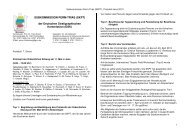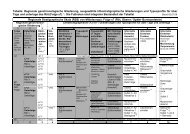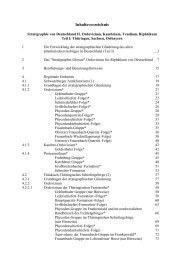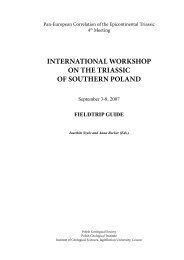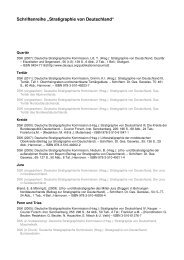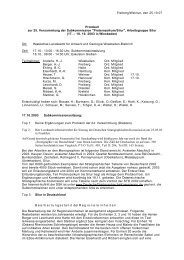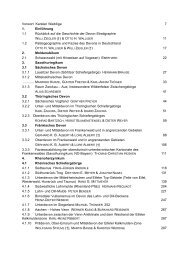International Field Workshop on 'The Triassic of eastern France'
International Field Workshop on 'The Triassic of eastern France'
International Field Workshop on 'The Triassic of eastern France'
You also want an ePaper? Increase the reach of your titles
YUMPU automatically turns print PDFs into web optimized ePapers that Google loves.
Figure IV.4: (A) Maps <strong>of</strong> retrogradati<strong>on</strong>al phase <strong>of</strong> the Carnian cycle. (B) Maps <strong>of</strong> progradati<strong>on</strong>al phase <strong>of</strong> the<br />
Carnian cycle. See Figs. III.2 and IV.1 for key. After Bourquin et al., 2002.<br />
4.2.4. Lower ‘Marnes irisées supérieures’ minor cycle or Norian Cycle<br />
In the east and centre <strong>of</strong> the Paris Basin, the base <strong>of</strong> the ‘Marnes irisées supérieures’ c<strong>on</strong>sists <strong>of</strong><br />
anhydritic coastal sabkha deposits (called ‘Argiles de Chanville’ <strong>on</strong> outcrops). Landward, in the extreme<br />
western part <strong>of</strong> the basin, the deposits c<strong>on</strong>sist <strong>of</strong> alluvial fan deposits <strong>of</strong> Chaunoy Sandst<strong>on</strong>es (Figs. I.1 and<br />
IV.1) exhibiting dolomitic palaeosols which are mainly well developed at the top (Bourquin et al., 1993,<br />
1998). The alluvial fan axis is oriented WSW-ENE and the terrigenous sediments were introduced from the<br />
WSW. To the east, these alluvial fan deposits pass progressively at their base into fan delta deposits in a<br />
lacustrine envir<strong>on</strong>ment, and are overlain by a braided fluvial system.<br />
This minor cycle is characterized in the west by a base-level rise in the Chaunoy Sandst<strong>on</strong>es. The<br />
maximum <strong>of</strong> the base-level rise is characterized by extensive flooding <strong>of</strong> the alluvial fan by lacustrine<br />
sediments. It is overlain by braided channel deposits or fluvio-lacustrine deposits. To the east, the base-level<br />
rise is recorded within the anhydritic coastal sabkha sediments (Figs. III.2, IV.2). The base-level fall trend,<br />
characterized in the central part <strong>of</strong> the basin by numerous well developped anhydritic strata, ends with an<br />
erosi<strong>on</strong>al disc<strong>on</strong>tinuity.<br />
33



